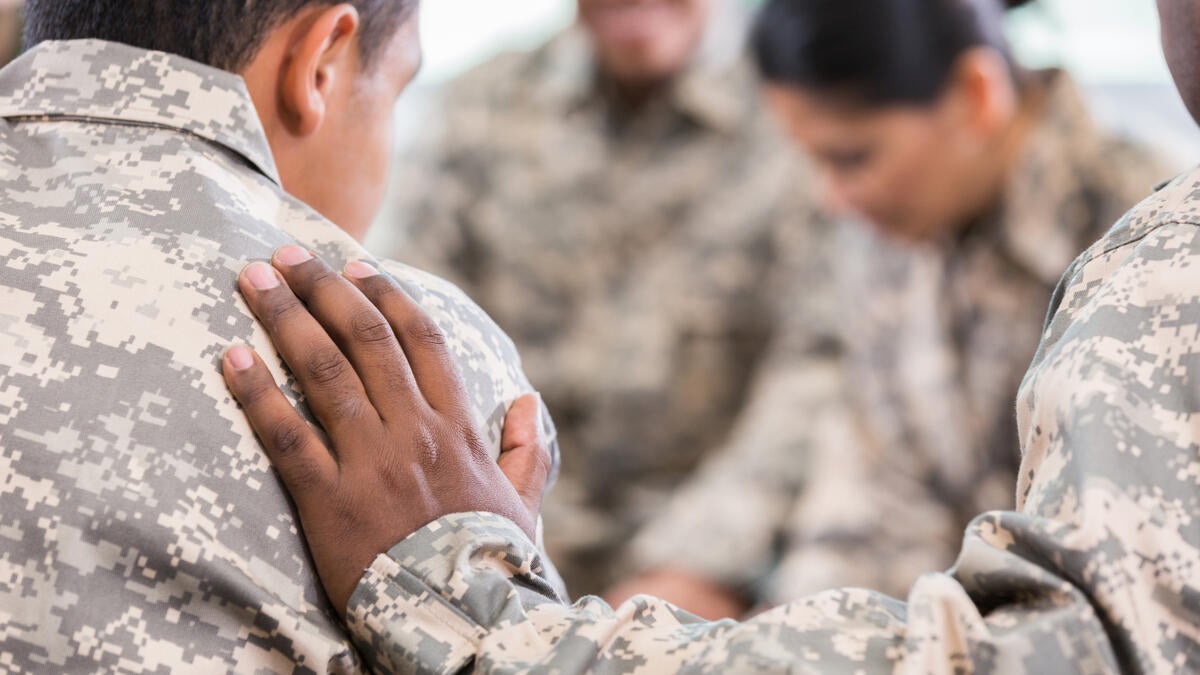Active-duty suicides are trending upward in all branches of the military, especially among women, and the U.S. secretary of defense wants to know why.
That’s why he’s called on a group of select individuals to dedicate a year of their lives to understanding this critical issue and report their findings to Congress.
Congress mandated the creation of an independent assessment of the issue, and on March 22, Lloyd J. Austin III, the secretary of defense, announced the formation of the Suicide Prevention and Response Independent Review Committee.
The committee of 10 includes clinical psychologists, epidemiologists, social workers, doctors, retired military and a chaplain. The group has expertise in suicide ideation and mortality, mental health disorders, substance use, sexual assault and weapon safety.
One of the members is clinical psychologist Rebecca K. Blais, an associate professor of psychology at Arizona State University. Her research studies the link between military sexual violence and suicide and how to best support military service personnel after these experiences.
Since May, Blais and the nine other members of the committee have been traveling to various military installations to collect intelligence and gather information from key players. She has also been making monthly visits to the Pentagon where the committee has an office.
In December the committee will deliver a report to Austin that makes recommendations for policy changes for the military community at large. The findings and recommendations of the committee will be presented to Congress in February 2023 and will be implemented by the Office of Force Resiliency.
ASU News spoke to Blais about her committee work in recognition of National Suicide Prevention Week, which is Sept. 4–10.
Rebecca K. Blais
Question: Congratulations on being named to the Suicide Prevention and Response Independent Review Committee. What does it mean and how big of a deal is this to you?
Answer: As a civilian coming from a military family, it is a great honor. Having not served in the military myself, this is a pivotal way that I can give back even more directly to my family and my country. I’ve been fortunate because part of this designation means I’m able to go to these miliary installations and see things for myself, which helps make me a better researcher, psychologist, academic advisor and human.
While seeing these events unfold is heartbreaking and terrifying, it is a necessary view to make us all better at reducing death by suicide. To be selected by (U.S. Secretary of Defense) Austin was another honor. I had the privilege of meeting him and it was clear that his commitment to these individuals was as deep and strong as mine. Combined with our dedicated team, I have to believe we can make a difference and reverse these trends.
Q: I understand that this appointment took you away from ASU for a year to work for the Department of Defense. What have you done in that time?
A: I started in May and was traveling back and forth from Tempe to the Pentagon for a period of three to four months. I met with the secretary of defense and other entities to understand how Washington views what is happening. For the next few months, I’ll be traveling to military installations both nationally and internationally and meeting with other key players.
Our team just got back from Nellis Air Force Base in Nevada and we’re heading to North Carolina in about a week to meet with the NC National Guard and Camp Lejeune, the latter of which is a Marine installation. We will be conducting these site visits till the beginning of November. We have already completed a site visit to Fort Campbell and will also visit Camp Humphreys (South Korea), three installations in Alaska and Naval Air Station (San Diego).
In November and December, we’ll be tasked with writing our final report, which will be given directly to the secretary of defense and then on to Congress. The final four months of our term will be testifying before Congress to push our agenda forward in getting what we think needs to change to get these suicide trends moving in a different direction.
Q: What are some of your key observations?
A: In addition to active military suicides going up, the acceleration is particularly noteworthy among women. Men are still more likely to die by suicide, but when you look at how steeply risk is increasing, we’re seeing (women's) rate increase faster than men. There are several systemic reasons as to why, and we will address these in our recommendations. We are also seeing increased risk among those who identify as LGBTQ, with top risk factors including failing romantic relationships, job stressors and difficulties navigating post-war society.
And, paramount among these issues, we are seeing high rates of racial and sexual harassment. Unfortunately, harassment and assault are perceived to be pretty normative in the military. When I’ve gone on these site visits, I’m being told that it’s “part of the culture and you just have to accept it.” As a civilian, as a psychologist and as a woman, I push back against that and say, “No, we do not accept this.”
Q: What are going to be some recommendations from the committee?
A: We need to reconceptualize what suicide is and not frame it as an individual issue. I hear frequently, “Oh, this service member was depressed or had PTSD. That is why they died by suicide.” PTSD and depression are contributing factors but it’s not the thing that leads to suicide. We need to be thinking about this issue as having independent factors as well as systemic factors that include military culture. We need to be doing more than targeting prevention among specific groups. That’s an older way of approaching suicide prevention. This is not, “Oh, it's tragic this person died of suicide,” but, “This person died of suicide. How did our community fail them?”
Q: What can we as civilians do to help our service members in the military?
A: The thing we can do as civilians to best help someone we know in uniform is to support them. That is to show that we care, show that they matter, and to be there when they call.
Kimberlee D'Ardenne, who is a science writer for the Psychology Department, contributed to this story.
Top photo courtesy iStock
More Science and technology

ASU and Deca Technologies selected to lead $100M SHIELD USA project to strengthen U.S. semiconductor packaging capabilities
The National Institute of Standards and Technology — part of the U.S. Department of Commerce — announced today that it plans to award as much as $100 million to Arizona State University and Deca…

From food crops to cancer clinics: Lessons in extermination resistance
Just as crop-devouring insects evolve to resist pesticides, cancer cells can increase their lethality by developing resistance to treatment. In fact, most deaths from cancer are caused by the…

ASU professor wins NIH Director’s New Innovator Award for research linking gene function to brain structure
Life experiences alter us in many ways, including how we act and our mental and physical health. What we go through can even change how our genes work, how the instructions coded into our DNA are…

